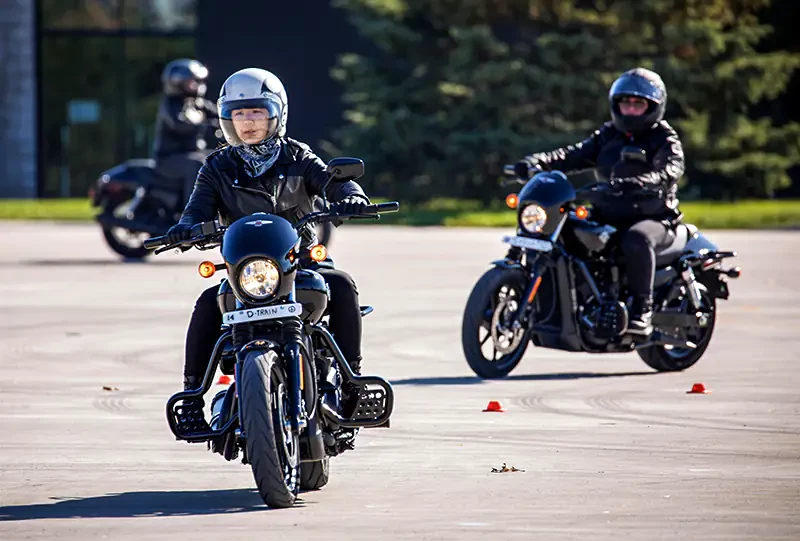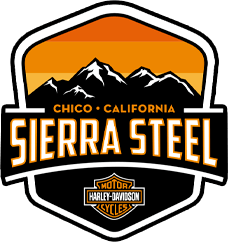

Never ridden before? Want to get your license? The New Rider Course will lead you through the steps to learn to ride a motorcycle and get you on the road.
- Friendly, enthusiastic California Motorcyclist Safety Program® (CMSP) certified Instructors make learning a breeze.
- Classroom time gets you familiar with the bike, its controls and the inner workings of a Harley-Davidson dealership.
- Learn the basic motorcycling skills on the range with a Harley-Davidson Street 500 motorcycle provided by the dealership.
- Successful course completion may streamline your motorcycle licensing process and may help you get a discount on motorcycle insurance.
- The course is 15 hours total which includes 5-hours of classroom instruction and 10 hours of actual riding.
- Riding a two-wheeled bicycle is a pre-requisite for taking the MTC.
- Learn to ride on a genuine Harley-Davidson® motorcycle
- Classroom and range instruction from state & Riding Academy certified instructors
- Learn to safely accelerate, shift, brake, and turn, along with maneuvers like controlling skids and surmounting riding obstacles
- Earn a Motorcycle Safety Course Completion Card, which may exempt you from the riding portion of your state license exam and score you a discount on motorcycle insurance

Frequently Asked Questions
After enrolling, you should be contacted by your dealership with any specifics to your course, including what to bring, what is required, and where and when to meet. Some dealers will have the instructor call you, welcome you, remind you of items to bring and answer any questions you might have about the class.
- A government issued identification card
- Be over the age of fifteen and a half
- The ability to ride a bicycle
- Credit card for payment
*You do not need a motorcycle permit to take this course*
Gloves and a helmet are the only essential motorcycle specific items, but we recommend that sometime before the first night of class, take what you have to the dealer to get it checked out.
They can help you ensure that you have the right equipment.
CLASS GEAR LIST
- Long-sleeve shirt or jacket
- Long pants (heavy denim or riding pants recommended)
- Over-the-ankle boots (sturdy, not canvas, low heel)
- Eye protection (helmet visor, eye glasses, sun glasses, goggles acceptable)
- Full-finger gloves (motorcycle specific recommended)
- DOT-certified helmet style based on the requirements of your state
SHOPPING FOR A HELMET
A helmet is the most important piece of motorcycle gear you will invest in. A helmet is a very personal piece of gear.
Consider buying a helmet vs. borrowing one, that way it is yours and it fits you perfectly and allows you to focus on learning to ride.
The staff at your dealer are trained to fit a helmet and will ensure you get the right one. Helmet fit is so important that they will most likely suggest you wear the one you settle on around the dealer for about 15 minutes.
It takes that long for the helmet to really let you know if it will be comfortable in the long run. Remember, helmets are not typically returnable once they leave the dealership, so take the time to find the right one.
Instructor Tip: The more helmet the better, full face is the best, followed by a modular. An open face helmet or ¾ open still provides good protection if you feel too cooped up in a full face. Half helmets, while very popular, offer the least amount of protection.
There are a variety of schedules. This example of a typical weekend course will give you a feel for what to expect.
The first class meeting typically runs three hours: You’ll get a tour of the dealership, fill out all the class paperwork and get to know your peers and instructors. During the paperwork session, you will hear a lot about counseling and being on time and having all the gear. Don’t fret, it is just to set clear expectations for everyone. Being that an endorsement waiver is provided through this class, it has some structural aspects that the state requires to allow for licensing.
A lot of what is being discussed you have already seen firsthand as a car driver. Then the class will turn to new material – an activity to help demystify motorcycle controls and their use will be held, as well as an activity to help understand important aspects of riding gear.
At the end of the night, instructors usually spend some time talking about the range days, what to bring, where the range is and when to be there. The range is simply a practice lot; it is a large flat piece of pavement that may be on dealer property or down the road a few miles.
This site is usually blocked off from car traffic and offers a controlled environment to learn in. The classroom will probably conclude with a discussion on the range rules and hand signals. These are all intended to help you understand how the range works and to ensure everyone has a good time during the riding portion of the course.
Instructor Tip: If you are not sure where the range is, take time to drive by it on the way home versus frantically searching for it in the morning.
Pack whatever snacks you need to keep going physically and mentally, bottled water is usually provided by the dealership.
If it’s passed 10 minutes of the check-in time, you will need to contact 530-893-1918 to make arrangements to reschedule as per the site policies.
Government-Issued, valid photo ID & Confirmation Letter
- A DOT-approved helmet, 3⁄4 or full-face (No half helmets) Personal helmets are subject to inspection for DOT-compliance and to make sure that they are in good working condition.
- Either full-fingered street specific motorcycle gloves or 100% leather gloves
- Eye protection including shields, sunglasses, goggles, or glasses
- Long-sleeve shirt or jacket
- Long pants, jeans, or leather with no tears or holes
- Over the ankle boots with little or no heel. Thin fabric shoes made of canvas or other fabrics that do not provide support are not acceptable. The classic Converse All Star “Chuck Taylor” or dress shoe are examples of shoes that DO NOT meet the requirements.
Riding Academy Contact Information & Map
Riding Academy New Rider Course

